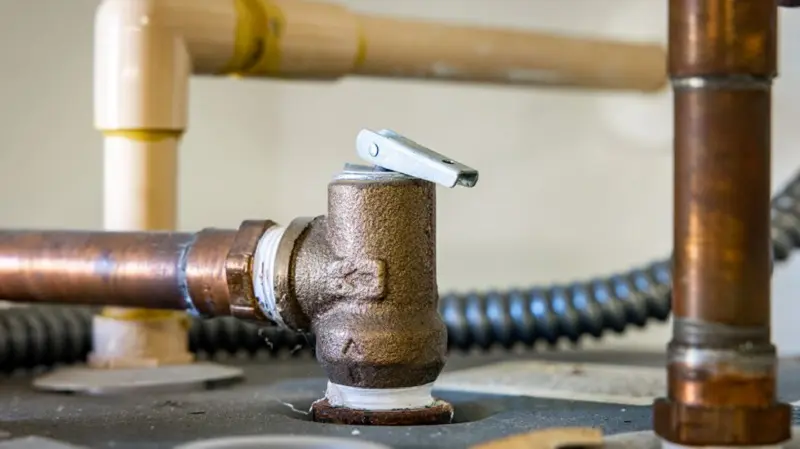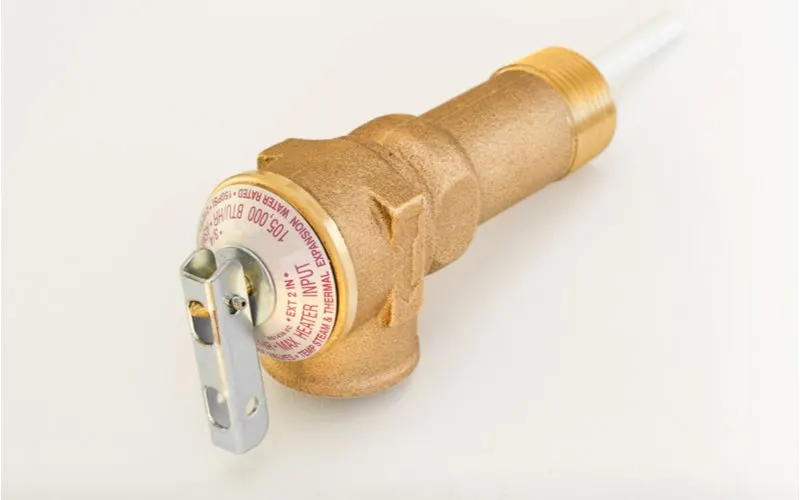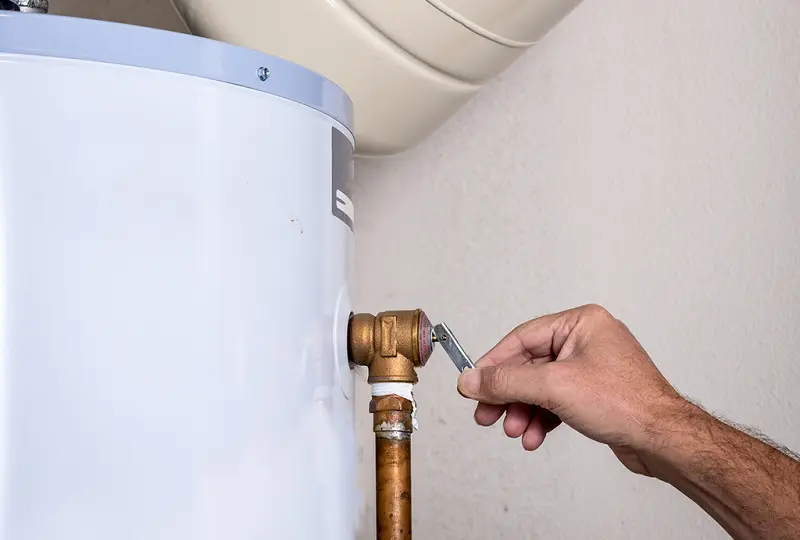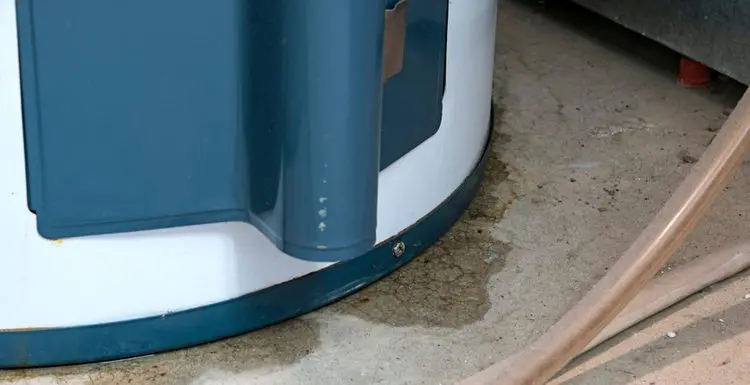Is your water heater pressure relief valve leaking? What is the cause, and what can you do to fix it?
If you’re asking any of these questions, you’re in the right place.
Read on to learn all you need to know to fix the problem.
We partnered with Networx to help you find local plumbers in your area. Click to below to get a FREE quote.
Why Water Heater Pressure Relief Valves Leak

The Toidi/Shutterstock
There are some common reasons why your water heater pressure relief valve might leak. One is excessively high temperatures in the water tank.
Either a gas burner or electricity heats the water inside the tank, and the pressure relief valve is a safety mechanism to make sure the tank doesn’t overheat.
When water is heated, thermal expansion causes pressure to build up inside the water tank. If the temperature gets too high, the valve will open up and drain out some of the hot water, replacing it with cooler water to lower the temperature.
This is a sign that the valve is working correctly and that occasional leaking is normal. Temperatures inside the water tank range from 120 to 140 degrees.
The pressure will be released if the temperature inside the tank gets to about 210 degrees and 150 psi (pounds per square inch).
If the valve is frequently opening due to high temperatures, it could be a sign of a safety hazard, and the water heater needs replacing.
Another possible cause of leaks is the valve not being appropriately sealed at the point where it connects to the water heater.
Another potential issue is that the valve itself is faulty. For example, if the seal is damaged or the valve sticks to the open position,.
If the water heater pressure relief valve is truly damaged and is causing the leakage, why is it a good idea to fix it right away?
- The high-pressure buildup could cause the tank to rupture or explode.
- Leaking water can cause damage to the structures surrounding the water heater.
- Excessive leakage can flood your basement and lower levels of your home.
- If the tank ruptures with people in the vicinity, they could sustain severe burns from the hot water.
Your Water Heater Pressure Relief Valve Is Leaking. Now What?

Kevin Brine/Shutterstock
What are some of the signs that your water heater pressure relief valve is leaking?
- Fluctuating or low water pressure. If you notice low or fluctuating water pressure, it could be a sign that your water heater pressure relief valve is leaking. For example, if you are using the bathroom sink and the pressure gets lower when someone turns on the faucet in the kitchen, this may be a sign of a leak.
- There is no water pressure. Just as with low or fluctuating water pressure, no pressure is a sign that something may be wrong with your pressure relief valve.
- Loud noises are coming from inside the walls. If you hear loud banging or humming noises inside your walls, this may be a sign that your pressure relief valve is leaking. To make sure the sound is coming from the valve, go close to it and see if the sounds become louder.
What to Do When You Find a Leak
- Assess the leak. Find out whether or not the leak is from a normal pressure release or a bad valve. Replace the valve if needed.
- Do a valve test to see if the pressure relief valve is functioning properly. If a lousy valve causes the leak, contact a licensed plumber to replace the valve if you don’t have the skills to do it yourself.
- Check the frequency of the leaks. If you often have leaks due to the valve opening, you may have unsafe pressure levels, and your water tank is at risk of rupturing or exploding.
- Check the valve opening to make sure it can close properly. Minerals in the water may become encrusted on the valve opening over time. If the valve is leaking because it is stuck in the open position, open and close the valve a few times quickly to get it unstuck. If the valve still sticks, you know that you need to replace it.
- Check the pressure gauge. If the valve has no pressure, it could be due to a broken spring or the valve not fitting correctly. Controlling the pressure is a vital function of the valve, and replacement is a must.
Things to Consider

Charles Knowles/Shutterstock
If the leakage is severe, immediately turn off the water heater. If your water heater uses gas, locate the gas line, which is usually near the water heater.
Turn the gas valve clockwise until the gas is entirely off.
Locate the appropriate switch in your breaker box and set it to “off” if your water heater is electric. Next, turn off the water supply to stop more water from building up in the tank.
Use caution with a leaky tank, as the water is hot and could cause burns and serious injury. Replacing a leaking water heater pressure relief valve can be a DIY project, depending on the cause of the leak.
The valves are inexpensive, and you can do a quick fix in a few simple steps:
- Turn off the water heater breaker (allow 24-48 hours for the water to cool).
- Shut the water off completely
- Remove the valve and discharge tube.
- Replace the old valve and discharge tube with new ones.
- Slowly turn on the water.
- Turn on the water heater and let it fill up again.
When to Call a Pro
If the water heater pressure relief valve is often open and leaking, there could be an issue with your water heater. If your water heater is constantly at a high temperature, there is a high-pressure buildup.
At this point, it’s always best that you call a professional as soon as you notice since there is a high risk of explosion.
Repairs and replacements need to meet local plumbing codes, so it’s best to have a professional do the repair at this point.
We partnered with Networx to help you find local plumbers in your area. Click to below to get a FREE quote.
Frequently Asked Questions
How often should the pressure relief valve on a hot water tank be replaced?
Replacing a pressure relief valve is far cheaper than repairing one after something has gone wrong. CPV Manufacturing recommends replacing your pressure relief valve every 4-5 years, but you also need to factor in some other things.
- Location – Certain climates, particularly desert climates, can be hard on pressure relief valve seals. Heat and dryness can cause the seals to crack, so users need to replace them more frequently.
- Debris in your water – Debris in your water may be a sign of blockage or corrosion in the valve. If the pipes undergo a thorough cleaning process and the debris remains, it’s time to replace the valve.
- Age of the valve – The spring mechanism in the valve loses tension as the valve ages. This is why it’s essential to test your valve about every six months and replace the valve every 4-5 years.
Frequency of use – If your water heater pressure release valve is in high use, it may need to be replaced more frequently due to the wear and tear caused by this usage. - Water quality – Minerals build up on the water heater pressure relief valve over time. If you live in an area with hard water, mineral deposits may build up quicker. Mineral buildup on the valve can cause the valve to stick. If it is stuck in the open position, it will leak. If it is stuck in the closed position, it will not open when pressure release is needed, risking pressure buildup in the water tank.
Where Is the Water Heater Pressure Relief Valve located?
Water relief pressure valves are usually located on the side or top of your water heater. The valve connects to a discharge tube that is made from either plastic or metal.
What Are the Signs of a Leaking Water Heater Pressure Relief Valve?
Fluctuating, low, or no water pressure are signs that the valve is leaking. Check your valve if you notice any unusual changes in your water pressure.
How Do You Test a Water Heater Pressure Relief Valve?
Lift the lever on the top of the valve to verify that the hot water is being expelled from the overflow tube.
Quickly release the lever, and if it doesn’t spring back into place quickly, it means that you will need to replace the valve.
Use caution when testing your valve to prevent hot water from being slashed on you. Some plumbers recommend testing the valve every six months, while others recommend testing it every two years.
Why’s Your TPR Valve Leaking?
If your water heater pressure relief valve is leaking, there’s no need to panic. A simple replacement of the valve can easily fix the issue.
Testing your valve regularly can prevent costly repairs in the future. You should also check if your heater is leaking from the bottom or the top, just to be sure.
Pay close attention to the frequency and the level of the leaks so that you know when it’s time to call a professional. Test valves regularly and replace them when necessary to avoid costly repairs in the future.
In case you still have questions, we have addressed the most common inquiries on pressure relief valves below.


